#He makes his figure resembles Seto just to bully Yugi
Note
Could you elaborate on what you mean about Death T re stanning and fairness? It sounds interesting and I'd love to hear about it if you don't mind sharing.
ajhfakj hoo boy. Okay.
So some time around the summer before last (judging by the point where the first baffled and frustrated readmores start showing up on this blog), I read Death-T. It made me feel…some kind of way. An…unpleasant kind of way.
Here’s the thing about me: I can’t just let myself have an emotional reaction to a piece of fiction. I have to, first, pick apart my own emotions to figure out why I had that reaction, and second, pick apart the story to figure out how it works and how it made me feel that way.
On the Feelings Front, I’ve isolated two main causes:
1. I have a brain that Needs Things To Be Fair. That doesn’t mean I can’t handle unfairness in a piece of fiction. Unfairness creates conflict, and conflict is what makes for good storytelling. But it does mean that I need the story to be aware of its own unfairness. I need the unfairness to be the point. Otherwise I start vibrating at high speeds and shaking my fist at clouds.
2. I’m a Kaiba stan. I accidentally got emotionally attached to the Funny Card Game Boy from the Funny Card Game Show.

There’s the feelings part. That leaves the “picking apart the story” side of the equation. And I’ve been trying to do that in nice punchy little one-or-two-paragraph text posts for the past year or so, but I don’t think I’ve ever really done the argument justice that way. So I guess that leaves only one option: writing a giant wordvomit essay on Yugioh (1996-2004).
Why This Is A Death-T Hateblog: The Masterpost
An important note: I like being able to back up my thoughts with Evidence From The Text, but I’m specifically working off the (Viz translated) manga. You can read Cards with Teeth here, Capumon here, and Death-T starting here if you want to check any of my facts or draw your own conclusions. Keep in mind that the Toei anime made pretty huge changes to the s0 Kaiba storyline, and the DM anime skipped most of it entirely–if you’re more familiar with those continuities, there’re some major differences in the manga.
(Also this thing probably reads better on desktop. I think the formatting got screwed up on mobile)
How We Got Here
Before we can actually dig into Death-T, we need to start at the very beginning (♫a very good place to start♫). So that means taking a look at “The Cards with Teeth (Part 1)” and “The Cards with Teeth (Part 2).”
For its first 8 chapters, the Yugioh manga chugs blissfully (if repetitively) along with an episodic, conflict-of-the-week formula. No overarching plot. Next to no sense of continuity. No trading cards in sight.
Then this asshole shows up.
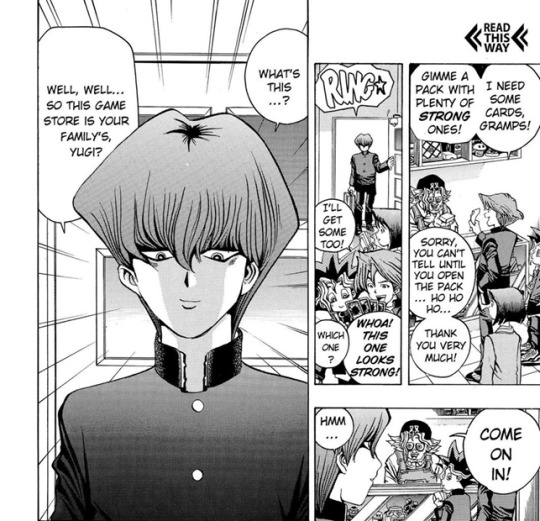
His name is Seto Kaiba (or “Kaiba,” at least–not sure if this is just a Viz thing, but my copy of CwT never mentions his given name). Not that he bears a whole lot of resemblance to the Seto Kaiba we later come to know and love (and/or love to hate).
Almost none of his most defining traits are there yet. There’s no mention of Mokuba, no mention of Kaibacorp, no indicationthat he’s especially rich (besides the fact that he’s carrying around a wholebriefcase of trading cards), no reason to believe he has a specific obsession with Blue Eyes (he just thinks it’s a strong card and it’d help him win tournaments), and no sign of any special hacking/strategy/hand-to-hand-combat/etc. skills (the kid is hilariously incompetent).
This dude was never supposed to be a recurring character, and it shows.
But anyway, let’s run through the basic series of events:
- Kaiba wanders into the game shop looking forbooster packs. Yugi recognizes him as an acquaintance from school (not as a famous kid CEO, and not as a recent transfer student)
- Kaiba happens to notice the Blue Eyes card lying out onGrandpa’s counter (in this version of events, he hasn’t been stealing rare cards for months before this, he didn’t creep on Yugi’s conversation and followhim home, he had no idea going in that the Blue Eyes was there, and he didn’t already have the other three)
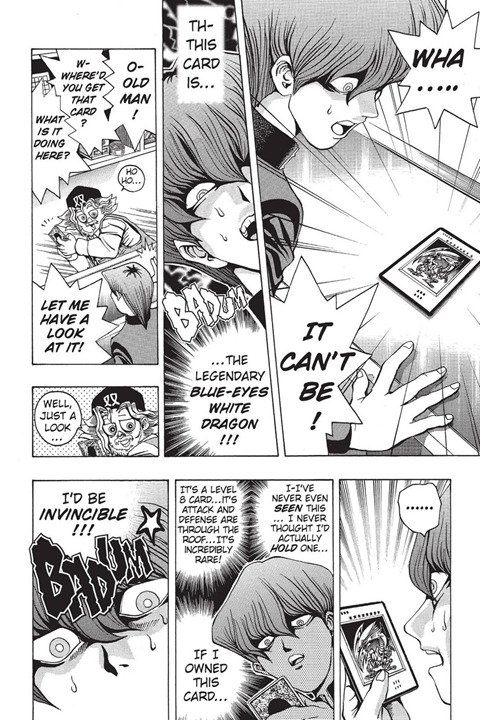
- He offers to trade all the cards in his briefcasefor the Blue Eyes (although he doesn’t tell Grandpa to name his price—again,the millionaire CEO element isn’t a thing yet)
- Grandpa refuses, so the next day Kaiba comes up with alaughably badly thought-out plan to steal the card
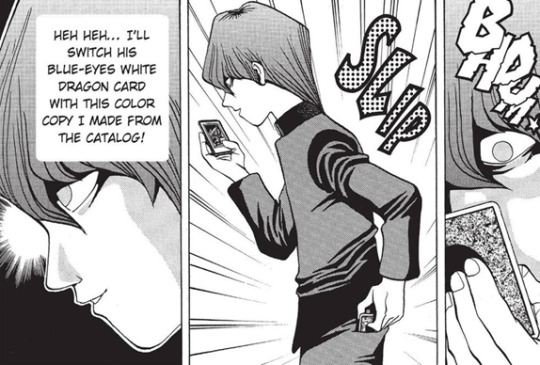
- Shockingly, Yugi notices that the “color copy from the catalog” isn’t the real deal. He gently tries to confront Kaiba about it in private
- Kaiba (without showing an ounce of the cool head you’d think you’d need to take over and run a company) panics, starts stammering and unconvincingly denying it, and then smacks Yugi with his briefcase

Annnd then Part 2 plays out like a standard s0 chapter.
“Yami Yugi” takes over. They play a shadow game. Kaiba cheats by slipping the stolen Blue Eyes out of his sleeve (Atem’s like “That’s my Grandpa’s card!” and Kaiba straight up goes “Whaaat, nooo, that’s my card that I, uh, found on the street just now.” A teen genius criminal mastermind, everybody). The shadow magic gives him a spritz from its metaphorical Karmic Cat-Training Spray Bottle and makes his Blue Eyes dissolve (I’d like to think that was Kisara going “I’m not mad, just disappointed,” and Memory World tries to retroactively make that connection, but it’s pretty abundantly clear that nothing about this series was planned that far ahead). He loses. Yadda yadda yadda.
And then Atem goes in for the penalty game.
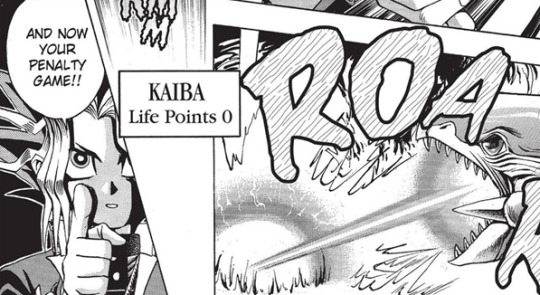


To recap:
Some random 10th grader from Yugi’s school stole a trading card, hit someone, and was generally kind of a jerk. As punishment, he was trapped in a hyper-realistic illusion of being ripped apart and slaughtered by half a dozen monsters at once.
Y…ay…?
Let’s Stop and Reflect for a Sec
In theory, I shouldn’t be that much more upset about Cards with Teeth than I am about any other part of s0, right? It’s not like the manga framed it as horrific and wrong when Atem set off an explosion in some teenage bully’s face a couple chapters ago. Giving us the vicarious pleasure of punishing our bullies in over-the-top, Carrie-style ways without actually exploring any of the consequences is, like, the early manga’s whole thing.
But even taking into account the fact that I already had an attachment to this Nasty Bowl Cut Boy thanks to the anime, I do actually think that there are at least two factors that set CwT apart.
The first is that Atem’s karmic punishments are usually…well, karmic. If he inflicts physical harm on someone, it’s because they already inflicted or tried to inflict roughly the same amount of harm on Yugi & co. If the crime was relatively minor, then he only gives out a minor punishment–like, say, when the homeroom teacher was Just Kinda Mean, all he did was allow the class to see her without her makeup on (…setting aside the Let’s Get Into Gender Politics-ness of that chapter).
There’s even a few cases where you could argue that the punishment is too light to fit the crime. Ushio beat Jonouchi and Honda half to death and tried to murder Yugi with a knife, and all he got was this lousy t-shirt an illusion that made the trash on the ground look like money.
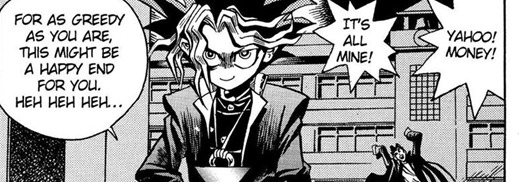
In another chapter, the villain of the week tried to rape Anzu, and the only punishment he faced was having his side business exposed as a scam (Let’s Get Into Gender Politics).
Yet in CwT, we see one of the most harmless villains in all of s0 (no prolonged beatings or attempted murder? unheard of!) receive what’s arguably the most horrifying penalty game in the whole manga. At least when that guy got set on fire, it was over fast.
And that brings us to factor number two: Kaiba is the first penalty game victim in s0 who comes back.
Capumon: Gotta Catch ‘em All!
Well, technically he doesn’t come back in person, at first. Someone else shows up to fight in his name.
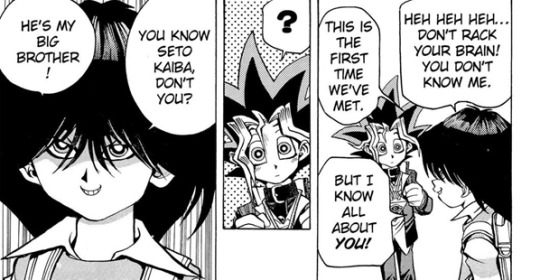
Oh hey Mokie. How’s it going?
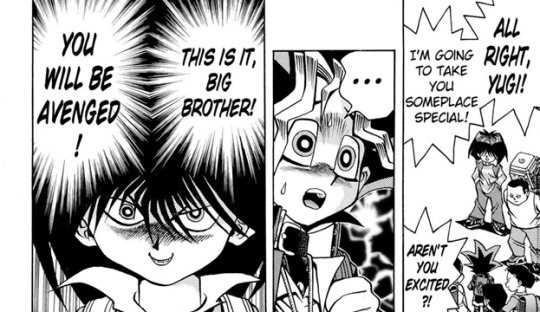
Rather understandably (imo), Mokuba wants the guy who tortured his brother last week to face some actual consequences for it.
Now here’s an interesting opportunity that the manga has set up for itself. Is it going to dig deep into the balance between defending yourself vs lashing out and causing undue harm? Is it going to remind us that most of the penalty game victims so far, whatever their crimes,have been children? Is it going to demonstrate that when you take out your anger on someone, you don’t just hurt your immediate target, but their loved ones as well?
Nah, who am I kidding.
Hurting or inconveniencing the Good Guys in any way is Bad. Anything the Good Guys do is Good and Justified. Using magic to stick an already-hurting eleven-year-old in his own personalized hell? Good and Justified.
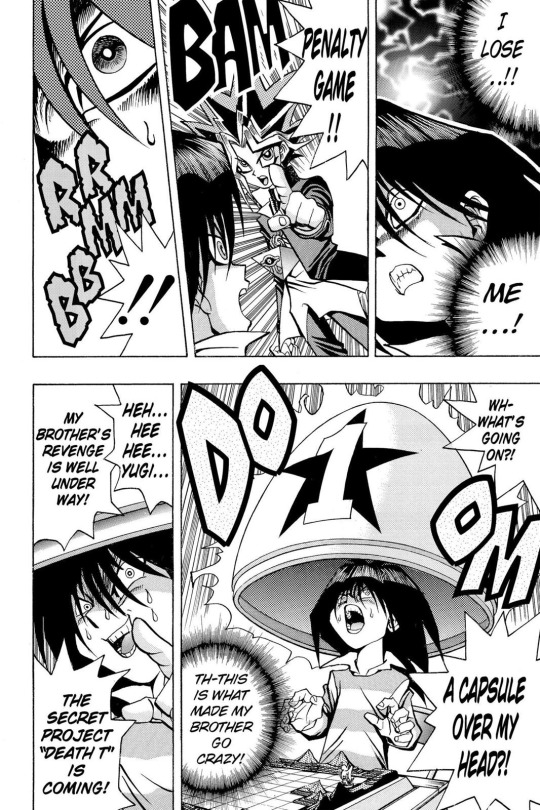
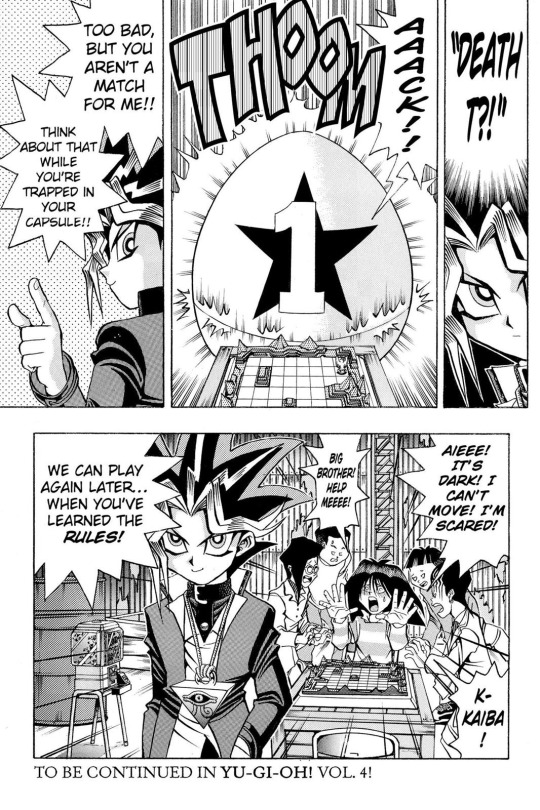
Before he’s shoved screaming into the Giant Vending Machine Capsule Where Bad And Naughty Elementary Schoolers Go To Atone For Their Crimes, Mokuba mentions that the other penalty game he heard about “made my brother go crazy!”
He also drops a hint of things to come with all the subtlety of an anvil. So I guess by this point, the numbers had come in and the card game chapter had proved unexpectedly popular enough that a sequel was in the works.
Death-Twink? Death-Tastic?Death-Two: Electric Boogaloo?
I’ve been pretty hard on Cards with Teeth and Capsule Monsters Chess so far. But you want to know the truth?
On their own, they aren’t necessarily that bad.
What really matters in a story isn’t the literal events: it’s how those events are framed. At the moment, we’re only midway through an incomplete storyline. Maybe we’re supposed to be horrified. Maybe we’re supposed to be questioning whether or not the hero is really in the right. It all hangs on what these chapters are building to.
As it turns out–as Mokuba just helpfully clued us in on–they were building to Death-T.
And that’s where the shit hits the fan.
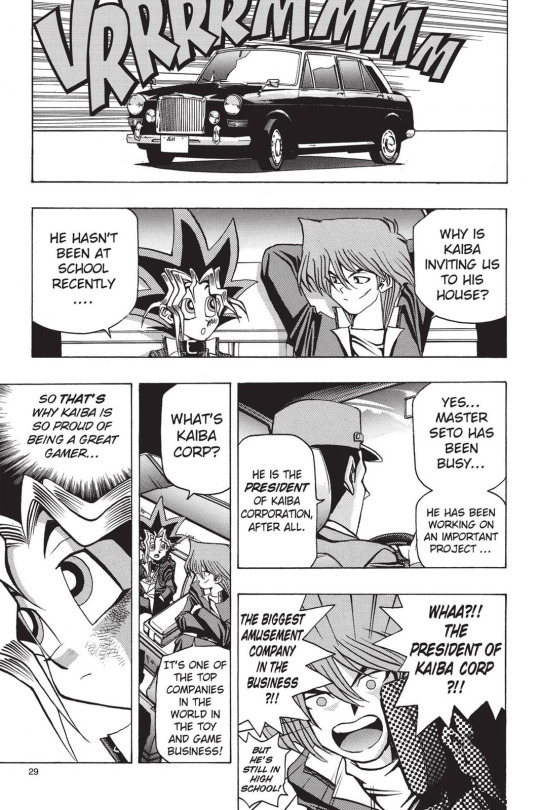
Over a dozen chapters after we first met Kaiba, a whole bunch of completely-unforeshadowed facts about him are suddenly dumped on us all at once. He’s rich! The kind of rich that allows for limo rides, a giant mansion, and flouncing around in a fur-lined cape like feudal European nobility! And he’s the president of a company, even though “Whaa?!! But he’s still in high school!” Speaking of which, apparently Kaiba “hasn’t been at school recently.”
The Death-T arc opens with Yugi and Jonouchi attending the world’s most awkward sleepover–the host never shows up, and they don’t even get to paint each others’ nails or watch movies. Also Mokuba tries to murder them in the night, but you know what? If someone tortured my brother, “made him go crazy,” and left him huddled in the house feverishly working on a bizarre project and refusing to go to school for the next few weeks, I’d probably poison them too.
The morning after the sleepover, we learn another new Kaiba Fact…
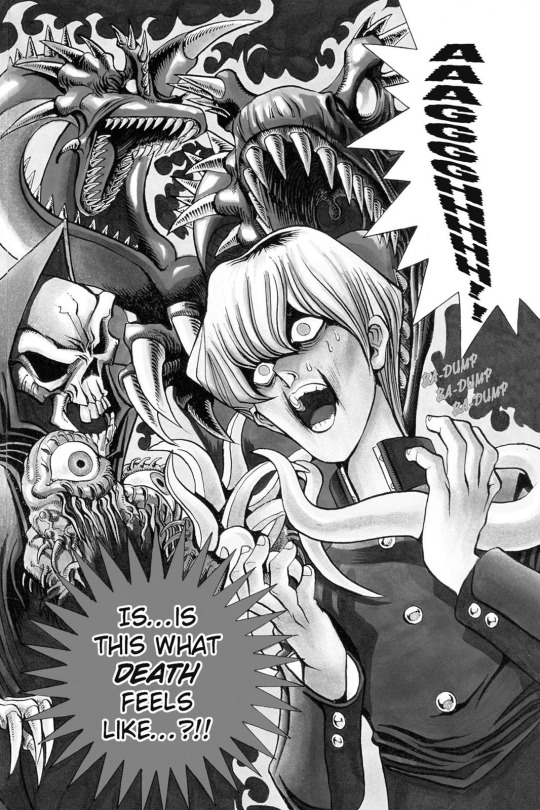
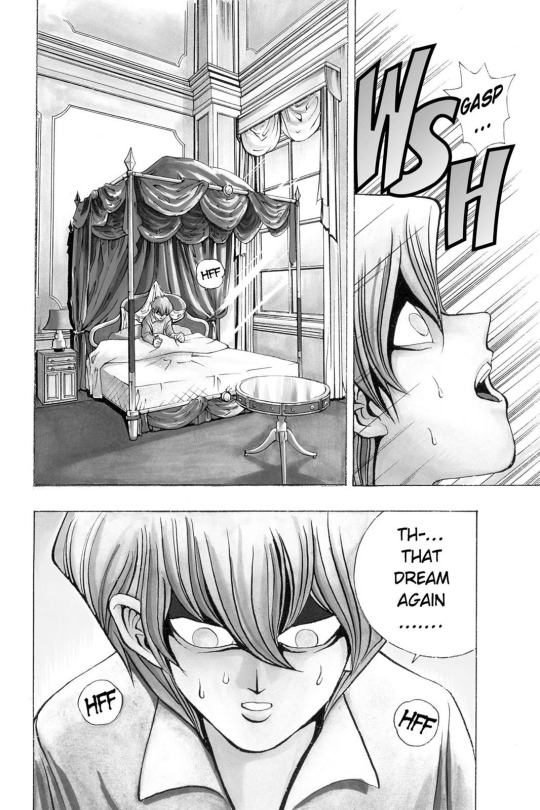
Ever since the Experience of Death happened, he’s been having horrible recurring PTSD nightmares about it. As you do. When you get tortured.

(This is why, even though I know intellectually that it’s Not That Deep and people arejust having fun, I still get a little skeeved out when I see jokes about howDeath-T happened “just” because Kaiba was that mad about losing a card game or “just”because he had a crush on Yugi and he didn’t know how to deal with it. I’malways internally like “Nnno, I’m pretty sure it was the torture?”)
So far we’ve been shown in pretty brutal detail that our “hero” psychologically broke a fifteen-year-old for no good reason. The manga’s going to have its work cut out for it if it really wants to do a convincing redemption arc for its protagonist. And there’s no way it could possibly try to spin that random act of torture as an acceptable thing, right?
…right?
Crime and Punishment
That’s one of my first big problems with Death-T: to me, it reads as a way of trying to retroactively justify the Experience of Death.
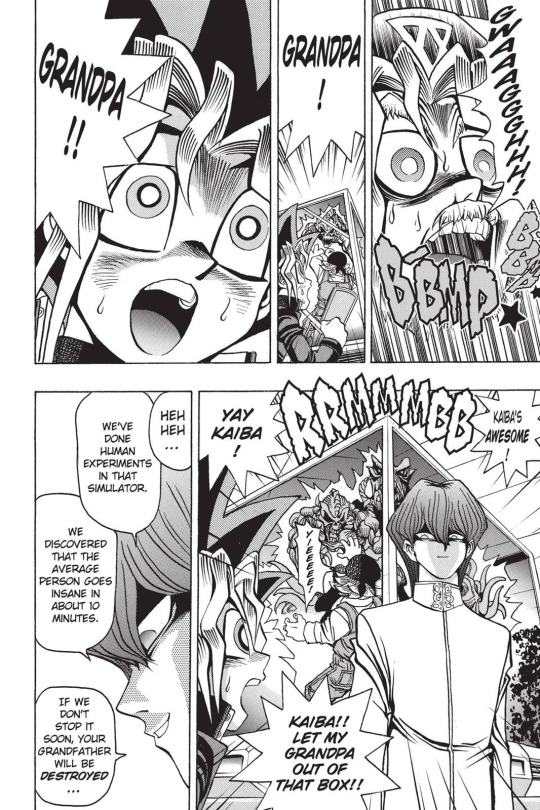
That seems to be the purpose of suddenly giving Kaiba all this wealth and power that was never hinted at in Cards with Teeth. See, he wasn’t just some random high school kid who had the bad luck of crossing someone with magic powers; he was (however improbable that is, as the story lampshades) a high school-aged CEO. He’s so ludicrously powerful that he can torture an old man in front of a live audience and get away with it. Punching up looks a lot better than punching down, doesn’t it?
And you can’t really fault the hero for torturing someone evil, can you? Kaiba used Grandpa’s sanity as a blackmail chip! He ran experiments on human test subjects! He wants to kill Yugi and everyone he loves! Surely a little torture is no worse than he deserved.
There’s only one one problem with that: the Experience of Death happened before Death-T. There’s no way Atem could have known any of this was coming. The audience couldn’t have known it was coming. Takahashi didn’t know. Chronologically speaking, the Experience of Death wasn’t revenge for Death-T. It’s the other way around.
Best Served Cold
So Death-T is a form of eye-for-an-eye vengeance: “Yugi” beat Kaiba at Duel Monsters and tortured him, so now Kaiba’s gonna beat Yugi and torture him, using his own perfect virtual recreation of “Yugi’s” penalty game (oh yeah, that whole “the average person goes insane in about 10 minutes” thing? Kaiba was able to program that detail from personal experience).
But wait! This isn’t really eye-for-an-eye! Kaiba’s going after Yugi’s loved ones, not just Yugi, and that’s worse than what Yugi did to him! And even if it was proportionate, revenge is bad and wrong. That’s how you get endless back-and-forth chains of vengeance and generational blood feuds and stuff. Two wrongs don’t make a right!
And those could all be reasonable points, except…
This entire story is about how great and badass eye-for-an-eye justice is.

“Wouldn’t it be cool if you could take everyone who ever hurt you and make them suffer even worse” is practically the thesis of Season 0. You can’t make something look awesome when the protagonist does it and then turn around and make it seem evil and inexcusable coming from anyone else.
And while Kaiba does wind up targeting Yugi’s friends, that wasn’t part of his original plan. He’s surprised when random people start jumping out of the bleachers/the Kaibacorp employee roster and insisting that they won’t let Yugi do this alone. The writing uses his surprise as proof that he just doesn’t understand The Power of Friendship, but it’s also evidence that his original target was just Yugi.

“If you’re gonna side with my torturer, then you can have the same fate as him, I guess.” It’s not even that far outside the logic Atem’s been using all this time. Just because there’s only one main gang member who personally hurt his friend, that doesn’t mean that Atem won’t rope every random mook who gets in his way into the death game too. (Granted, this doesn’t really apply to Kaiba’s treatment of Grandpa. Or the offscreen experimentation/blackmailing. Or Mokuba, but…we’ll get to that).
…But like I said before, the big issue isn’t the events. It’s the framing. Maybe the point will ultimately be that if penalty games are wrong when the bad guy does them, then they’re wrong when the hero does them too. Maybe this is all leading up to a big reexamination of Atem’s moral code and some much-needed character development.
Maybe. Let’s keep going and see.
*Great Gatsby comic voice* Baby? What Baby
Death-T runs for 14 chapters, but Kaiba isn’t actually there for, like…half of them.
I mean, he’s technically there? Occasionally? He’ll show up long enough to dramatically play chess for a panel or so, or to stick his head on a TV monitor and provide some Helpful Death Game Hints. But for all practical purposes, he’s pretty much absent for the entire middle section of the story arc.
And, uh…let’s just say I 100% understand and respect the DM anime’s decisionto go straight from Grandpa’s heart attack to the final duel and skipeverything in between.
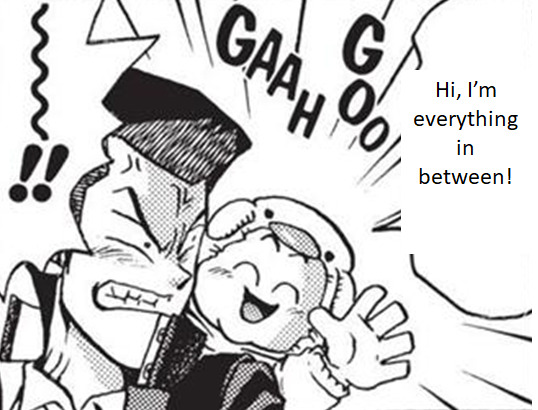
If Kaiba’s real goal is to beat Yugi at Duel Monsters, then all the death games leading up to that one are basically filler. And they manage to be just as contrived and nonsensical as any anime filler arc, without a fraction of the fun.
It’s largely a tonal issue. The writing swings wildly between grimdark dramatics, sentimental conversations about friendship where everyone hugs and cries (tbh that’s one of the few redeeming qualities of the arc), and “comic relief” where the “““comedy””” is all either bodily function jokes or sexual assault jokes (L̠̤̯͍̦e̮̪͎̞t's̞̮̳̱̰̦̲ ̲G͖͉̹̻̯͉͖e̜̝̗͓̟͚t̖͚ ͚̰̞̮̝̫͎I͓̜̦̳̭͚͎n̪̪͈t͍̥̰̼o͚͎͇̣̘̝ ̪̼̜̣̳G͈̠̫e̳̝̗̪ṋ͚̞͎ͅd͔̙͓̯̹e̯̺̯̩r͔̣̲͔̳̗ ̘͙P̖̦o̩̺͖͎̞̬l͎̺͕̹i͇̣̼̦t̰i̬̰̝͙̗̝c̜̼̺̪̲̞s).
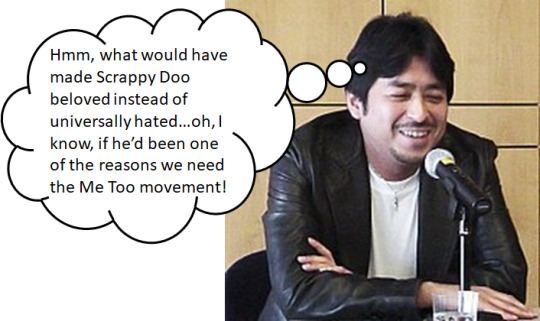
Honestly, in terms of the “stanning and fairness” argument, there’s not much to talk about here. It just adds insult to injury that not only does Death-T throw my fave under the bus, but it’s really badly written.
The Mokuba Thing
Okay, let’s fast-forward through the filler zone and stoppp…here.
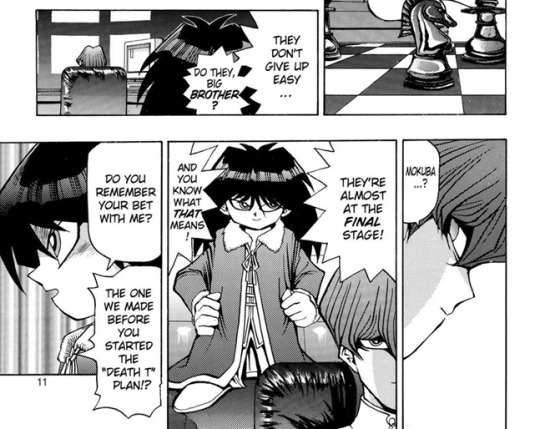
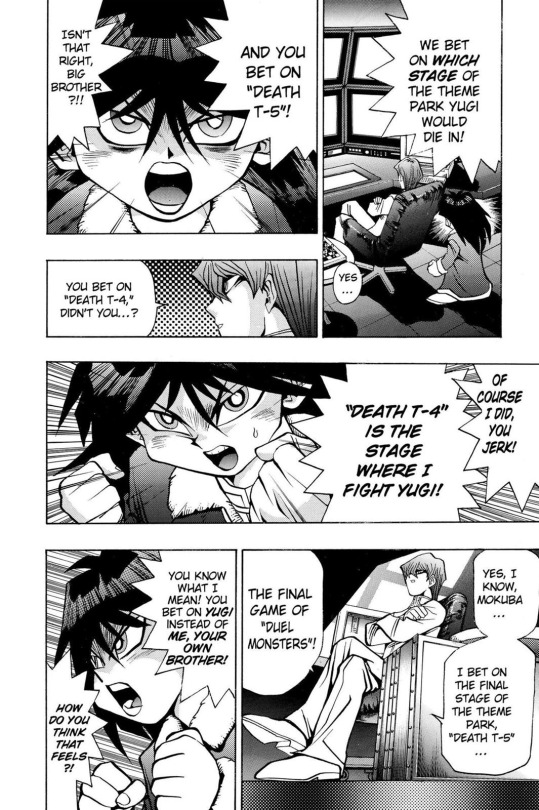
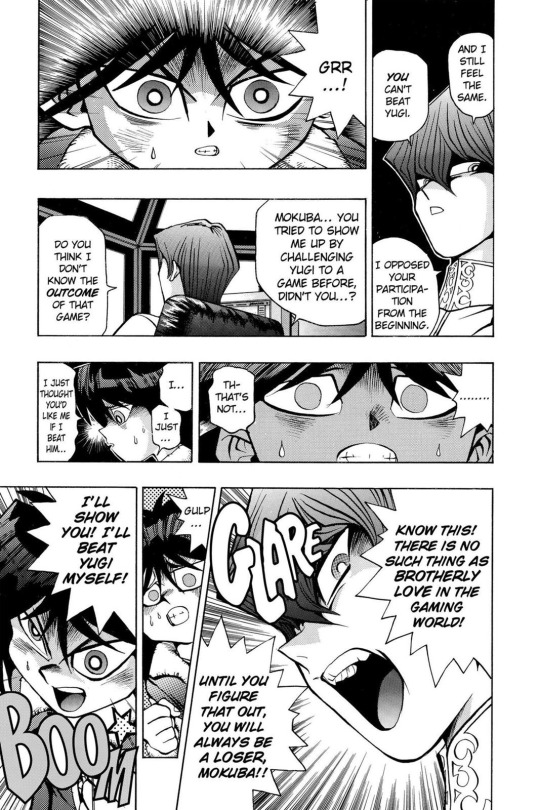
In the context of the anime, where we know (and see multiple flashbacks demonstrating) that their whole life has been an “us against the world” story, this scene is tragic. Seto’s trust in people has been eroded so much that he even thinks Mokuba is conspiring against him? Their love and support for each other, which has survived through so much hardship, has finally cracked under the weight of this latest trauma? There’s a lot of dramatic and tearjerking potential there.
I think it’s pretty safe to say that most of us bring our baggage from the anime with us when we read the manga. The vast majority of the western Yugioh fandom did start with DM.
But if we look at this purely in the context of the manga–if we can pretend, for a second, that none of us have ever heard of the anime–this is the first time we see the two of them interacting onscreen. And none of those touching flashbacks of Seto comforting Mokuba and defending him from bullies and promising to be his father exist here. All we ever really learn about their relationship before this point is “They used to be a little closer when they were younger. Source: one (1) photo of them playing chess.”
So instead of serving as the tragic lowpoint of their relationship, this scene sets the baseline for it: Mokuba desperately wants to make his brother happy and earn his approval, while Seto responds with dismissal and cruelty.
In the anime (and to a certain extent in the later manga), Mokuba’s purpose in the narrative is to humanize Seto. But in Death-T, he serves the opposite function. Every interaction they have is an opportunity for Seto to kick the dog and prove what a monster he is.
And it’s all downhill from here.
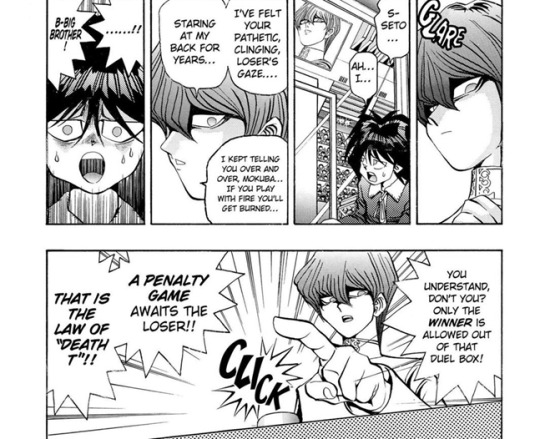
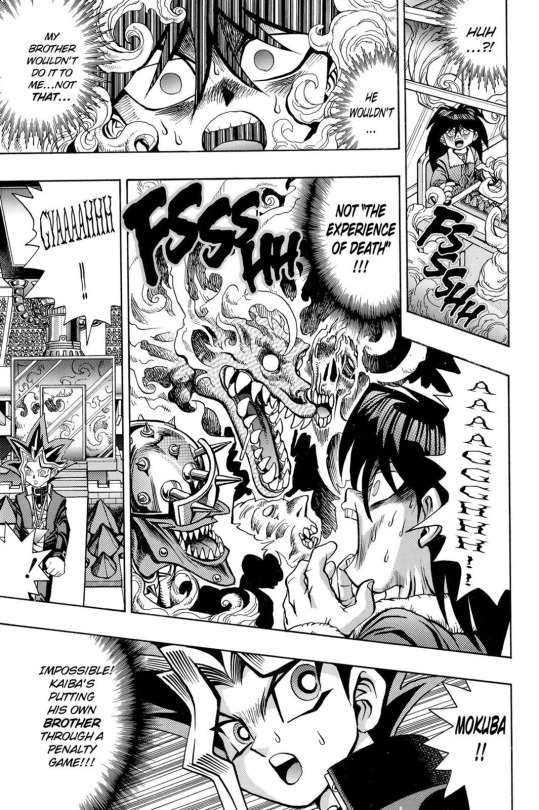
………………
…So.
I have…mixed feelings about this.
On one level–a meta level–I think this scene serves the same purpose as taking that random high schooler from CwT and suddenly giving him ridiculous amounts of money and power and mustache-twirling levels of villainy. It’s a way of making the Experience of Death seem retroactively justified (and also a way of making the upcoming penalty game look fair).
On the other hand. It’s.
Horrific.
This scene is supposed to make us hate Kaiba, and it does it’s job really really well.
Personally speaking? I’m of the opinion that trying to hurt the child under your care as badly as you conceivably can is a “don’t pass go, don’t collect $100″ kind of deal. There’s no coming back from that. There’s no fixing or salvaging this relationship.
(God, this whole thing is wrapped in so many layers of fantasy that I’m not even sure what the real-world equivalent would be. Trying to beat your child not quite to death?)
Mokuba should not have had to continue living with his brother after this, any more than the Ishtars should have had to stay with their dad or Seto should have had to stay with Gozaburo. Mokuba forgiving Seto for this isn’t touching to me, it’s gut-wrenching. Every “heartwarming” brotherly moment in the later manga (all, like…2 and a half of them) feels hollow and sad.
As far as I’m concerned, this scene doesn’t “complicate” their relationship in any interesting or meaningful way. Their anime relationship already has plenty of complications–their sometimes unhealthy co-dependence, the fact that Seto is still a kid himself and he’s not really equipped to be a parent,Mokuba’s difficulty understanding that Seto can’t just “go back to who he was” before his trauma, the times when Seto is too caught up in his own pain to really be there for Mokuba, the manipulation involved in Seto’s takeover plan, etc. This just makes their relationship outright child abuse.
But hey, they hugged that one time in Duelist Kingdom, so it’s fine, right?
ExODiA iiiIIIIT’s not pAHsible
The final duel happens. The big Blue Eyes vs Exodia showdown.
*Bill Wurtz voice* So that’s pretty nifty, I would say.
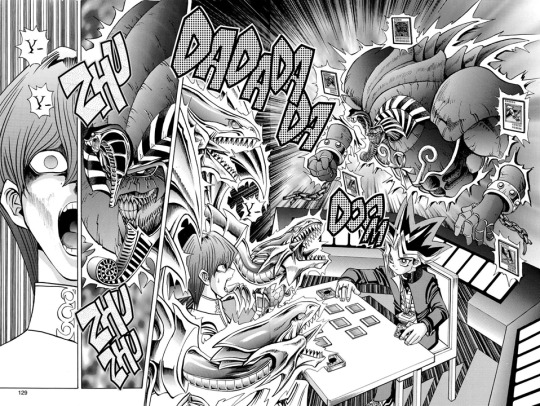
It’s..? A genuinely cool and dramatic duel. There’s a reason it’s one of the, like, three Death-T elements the DM anime actually bothered to keep. Not much to say about it.

Sure was a whole lot of buildup just to end things with one (1) deus ex machina instawin card, tho.
The Tragic Backstory
So if all this happened because of a penalty game, what do you think the solution could be?
Did you say “another, even harsher penalty game”?
Ding ding ding!

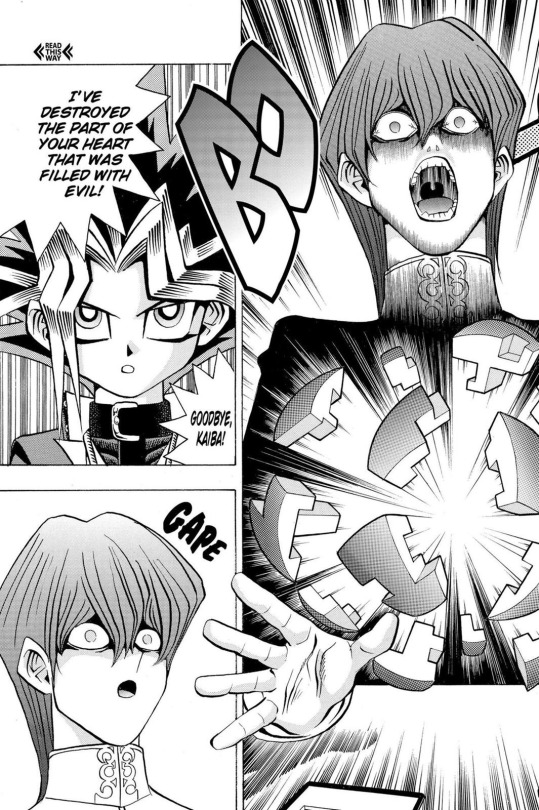
This time, instead of torturing the fifteen-year-old, our hero puts the fifteen-year-old in a vegetative state as he begs for mercy.
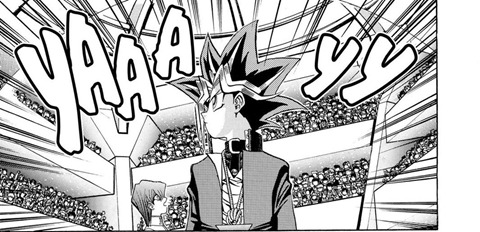
Yaaaayy!
Some fun facts about the Mind Crush that we don’t actually learn until Duelist Kingdom:
1. It lasted for 6 months
2. Mokuba spent that entire time alone, in the big empty mansion, with no parental guidance or adult supervision except the butlers and maids, caring for his brother’s comatose body 24/7
3. When Atem put Kaiba in that coma, he had absolutely no idea if he’d ever be able to wake up or not. He thought he could, maybe–Kaiba’s pretty strong, right? But he also finds the idea that Kaiba died in his coma and came back to haunt him perfectly believable. “Fixed,” dead…eh, it was kind of a coin toss.
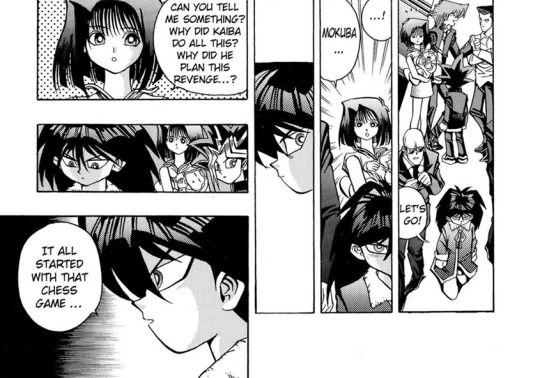
But wait, the story’s not over yet! First we have to find out Why Kaiba Is The Way He Is (“Because your buddy tortured him last month” isn’t enough of an answer, apparently).
This is communicated in the most natural way possible: Mokuba just starts monologuing about all his brother’s deepest darkest traumas to a bunch of strangers his brother hates.

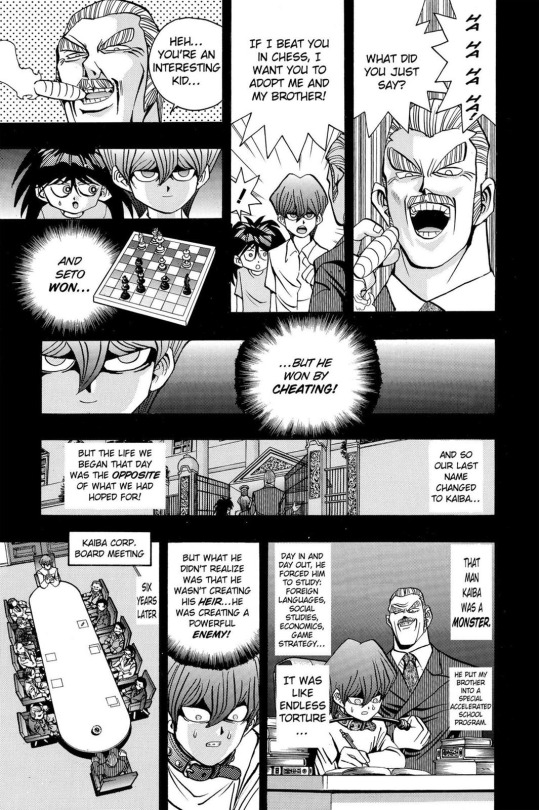
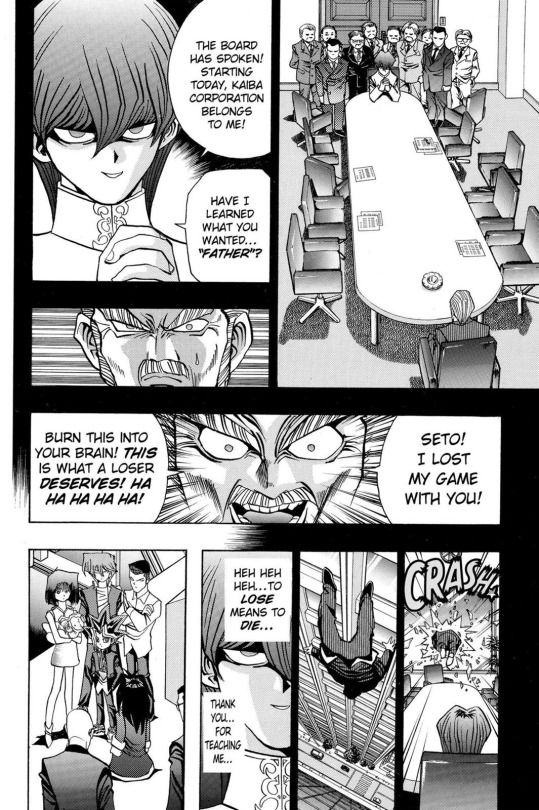
The claim that Kaiba’s backstory is “more complex” in the manga than it is in the anime has always confused me, because this is…it. These three pages are the whole backstory. I mean, in Battle City we do get one more passing line of dialog about how Kaibacorp used to be a weapons manufacturer and Gozaburo “sold Seto’s soul to the military industrial complex,” but other than that… The anime took these bare bones and fleshed them out significantly, but from a pure manga canon standpoint, it’s not a whole lot to work with.
But there’s still enough here to rub me the wrong way.
For one thing, this sequence is almost an exact parallel to two later moments in the manga: Pegasus’s backstory dump at the end of Duelist Kingdom, and Malik’s backstory dump mid-Battle City. In both of those cases, the purpose of the scene is to take a villain whose motives seemed cruel and inexplicable and finally reveal the reasons behind his actions. We’re supposed to be seeing these characters in a sympathetic light for the very first time.
But Kaiba’s motives in Death-T, uh, weren’t exactly a mystery. He already made it pretty explicitly clear that this was about the torture. So as a narrative tool, Mokuba’s monologue:
1. seems a little superfluous
2. seems like a way of taking any responsibility out of the protagonist’s hands. Kaiba didn’t snap because of anything Atem did, he just had a bunch of fucked up baggage that Atem couldn’t possibly have known about or accounted for. Who knew some people take it badly when you torture them??
3. seems to suggest that we weren’t supposed to be sympathizing with Kaiba before this point. If this is the big “oh, now that I know why he did it, I guess I feel a little bad for him :(” moment, then that means the part where he got tortured…wasn’t?
And, as always, there’s the issue of the framing.
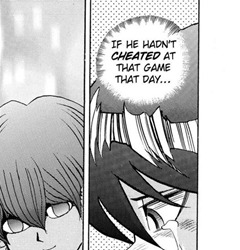
The grace note of the monologue–the thought it leaves us with, the intended takeaway–isn’t “If only he hadn’t gone through years of abuse, in circumstances he had no real control over because he was a child.” It’s “If only he hadn’t brought all this upon himself by cheating.”
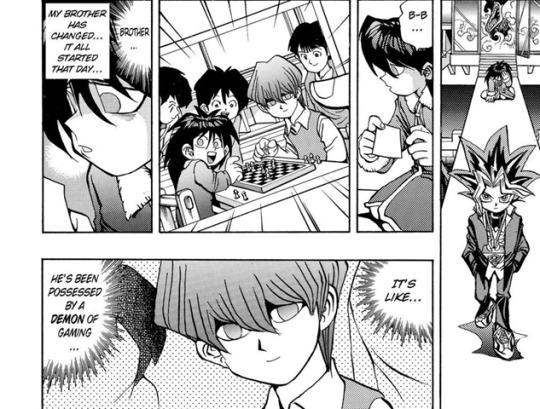
Even if we ignore the fact that it’s physically impossible to cheat at chess (which seems like kind of a big oversight for a gaming manga, but oh well, That’s Yugioh Babe)…
How can you possibly present a ten-year-old cheating at a board game in a desperate gambit to get himself and his brother out of an orphanage as his start of darkness?
Yet that’s exactly what the writing does. This is a story about how games “reveal the true hearts” of their players and bring karmic retribution down on anyone who doesn’t respect the game and follow the rules. The implication is that the child abuse Seto suffered was karma. He rightfully earned it by cheating at chess, just like he brought the Experience of Death upon himself by cheating at Duel Monsters.
Oh yeah, speaking of which…
Wheel of Morality, Turn Turn Turn, Tell Us The Lesson We Should Learn
What was the outcome of Death-T? What impact did it actually have?
Did it bring about any big moral reckoning? Any questioning of the heroes’ values? Did Atem learn the difficult but important lesson “torture bad”?
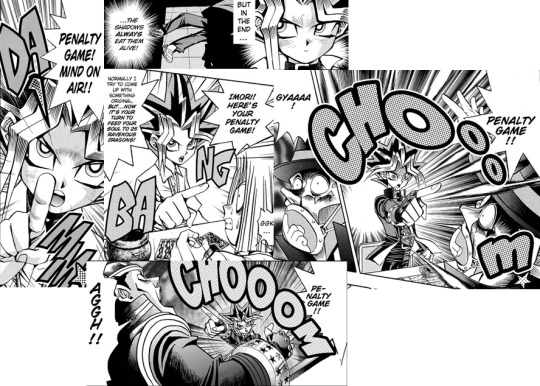
Nnnnope!
Death-T is immediately followed by a series of episodic chapters that take us right back to the status quo like nothing happened. Atem keeps merrily handing out penalty games all the way up to the very end of Duelist Kingdom. When he does finally stop doing them, his decision has nothing to do with Death-T. It takes a comment from Pegasus about the Millennium Items having an “evil intelligence” to make him wonder “wait…I’m from a Millennium Item…I’m an intelligence…could evil…maybe include…torture????”
And even after the manga lukewarmly reverses its position to “torture sort of bad I guess,” it never really does anything with that revelation. None of the past penalty games are ever reexamined. No apologies are made. The Experience of Death is quietly swept under the rug, and the Mind Crush, when it’s brought up at all, is framed as noble act that “fixed” Kaiba (because “if you make someone suffer badly enough, you can hurt them into being a better person” is a great message).
Basically, we learned nothing from Death-T, nothing changed, and our takeaway is supposed to be “Atem was 100% in the right and Kaiba was 100% in the wrong, and also he’s an evil monster who deserved everything he got.”
Guess I Need A Satisfying Conclusion of Some Kind Even Through Death-T Didn’t Really Have One, Huh
Wow.
That was…a whole lot of words of Death-T rage that I apparently had in me zjkghzkkf.
I tend to feel less justified about constantly harping on Death-T then I do when it comes to, like, the racism in Memory World, or the series’ general Miss O’Gyny. It’s not like “magical vigilantism” is exactly a real-word social issue that’s being reflected in this piece of fiction. I realize a lot of my anger pretty much boils down to “hey,, ! thats…my fave. stopp...being mean to him >:(”
But I also feel like the issues in Death-T aren’t limited to Death-T.
The manga has this…this thing where it wants to be able to pinpoint a few clear, unchanging moral rules (“cheating is bad!” “graverobbing is bad!” “patricide is bad!”) and just apply them neatly to every situation, without having to take into account any of that inconvenient stuff like “what were the circumstances of this specific situation,” or “how many choices were actually open to this person,” or “how much harm was done by this choice compared to its benefits in terms of basic human well-being.” Yet at the same time, that moral absolutism is somehow coupled with a reluctance to apply any moral judgement to its protagonists at all.
The two points where that becomes clearest are Death-T and Memory World. And I feel like even when people acknowledge the issues with those arcs, they still want to be able to write it off as “oh, that was just a problem with the early chapters, it was fixed as the writing matured,” or “oh, that was just a problem at the end because of the mad rush to finish the story before it got canceled, it was never a thing before then.” But it’s not an isolated problem. It’s there at the beginning of the story, it’s there at the end, and it’s baked into everything in the middle.
…but anyhow.
hey,, ! thats…my fave. stopp...being mean to him >:(
#'i like atem too and i ignore most of s0 bc of what it did to both their characters' disclaimer#long post#r...real long...#i am so sorry if the readmore doesn't work on mobile
184 notes
·
View notes